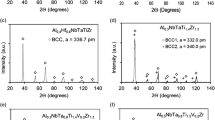Conclusions
-
1.
To obtain an austenitic structure and good physicochemical properties Fe−Mn−Al alloys should contain 8–10% Al, 25–30% Mn, and ∼1% C. An increase of the aluminum content and decrease of the manganese and carbon content results in α-phase in the structure, which impairs the magnetic and plastic characteristics of the alloys.
-
2.
After quenching from 1150°C and aging 16 h at 550°C the alloys of the optimal composition have the following mechanical properties: σb=90–95 kg/mm2; σ0.2=80–85 kg/mm2; δ=10–20%; ψ=15–30%.
-
3.
Alloys of the optimal composition have a density of 6.7–6.8 g/cm3 and a substantially higher strength than the widely used Cr−Ni steel 10Kh2N24 or the Mn−Al steel 45G17Yu3.
-
4.
Alloys with 8–10% Al have the same oxidation resistance as stainless steel 1Kh17N2.
Similar content being viewed by others
Literature cited
J. Ham, Product Engineering,52 (1958).
D. Schmats, Metal Progress,76, No. 4 (1959).
D. Schmats, Trans. AIME,215, No. 1 (1959/1960).
Additional information
Leningrad Polytechnical Institute. Translated from Metallovedenie i Termicheskaya Obrabotka Metallov, No. 2, pp. 13–16, February, 1969.
Rights and permissions
About this article
Cite this article
Kayak, G.L. Fe−Mn−Al precipitation-hardening austenitic alloys. Met Sci Heat Treat 11, 95–97 (1969). https://doi.org/10.1007/BF00652271
Issue Date:
DOI: https://doi.org/10.1007/BF00652271




